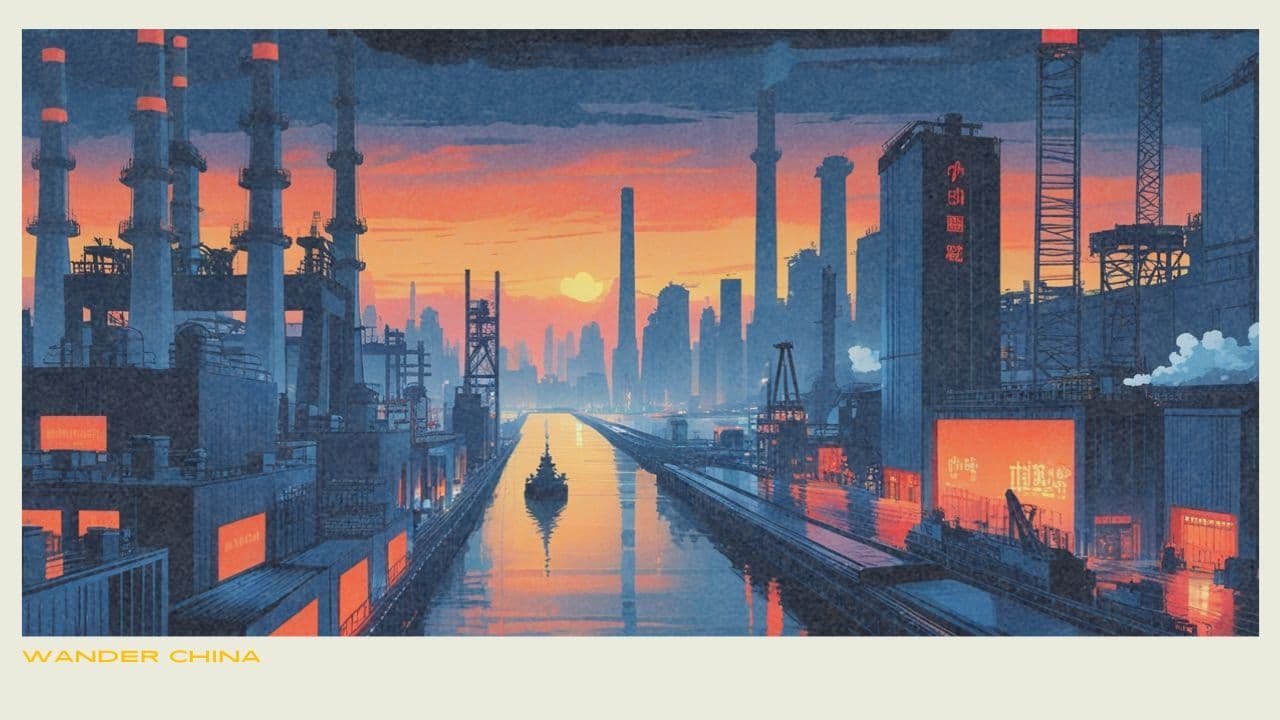The Engines of China: A Look at the Country’s Powerhouse Industrial Cities

The Rise of China’s Industrial Powerhouses
China’s meteoric rise as an economic superpower can be largely attributed to its relentless pursuit of industrialization and manufacturing prowess. Over the past few decades, the country has transformed from an agrarian society into a global manufacturing powerhouse, fueled by the rapid development of its industrial cities. These urban centers, scattered across China’s vast landscape, have become the engines driving the nation’s economic growth and technological innovation.
The significance of China’s industrial cities cannot be overstated. They serve as the backbone of the country’s manufacturing sector, producing a vast array of goods that cater to both domestic and international markets. From cutting-edge electronics and automobiles to heavy machinery and textiles, these cities have established themselves as leaders in various industries, contributing substantially to China’s GDP and employment opportunities.
Moreover, these industrial hubs have become hotbeds of innovation, fostering the development of new technologies, processes, and business models. The intense competition and collaboration within these cities have spurred a culture of continuous improvement and adaptation, enabling China to stay ahead of the curve in an ever-evolving global marketplace.
As China transitions towards a more sustainable and high-tech future, its industrial cities will undoubtedly play a pivotal role in driving this transformation. By embracing cutting-edge technologies, such as artificial intelligence, robotics, and renewable energy, these urban centers are poised to lead the way in shaping the next phase of China’s industrial revolution.
Why Industrial Cities Matter
These cities are not just production centers—they form the backbone of China’s economic and technological future. Key contributions include:
- Manufacturing Excellence: Production of electronics, machinery, automobiles, and more.
- Economic Engines: Significant contributors to GDP and employment.
- Innovation Hotbeds: Crucibles for next-generation technologies like AI, robotics, and renewable energy.
Top Industrial Cities and Their Specializations
| City | Specialization | Highlights |
|---|---|---|
| Shanghai | Automotive, Electronics, Financial Services | Pudong skyline, major automakers, tech parks |
| Shenzhen | Electronics, Hardware, Rapid Prototyping | Global tech giants, startup ecosystem |
| Guangzhou | Automotive, Petrochemicals, International Trade | Historic trading port, modern production complexes |
| Tianjin | Heavy Machinery, Aerospace, Petrochemicals | Coastal location, advanced manufacturing facilities |
| Chongqing | Automotive, Electronics, Machinery | Strategic inland location, robust logistics network |
| Wuhan | Automotive, Steel, Heavy Machinery | Resilient recovery post-pandemic, major automotive base |
| Suzhou | High-tech Industries, Electronics, Information Technology | Suzhou Industrial Park, “China’s Silicon Valley” |
| Dongguan | Consumer Electronics, Toys, Textiles | “The World’s Factory Floor”, adaptive manufacturing |
In-Depth Look at Major Cities
Shanghai: The Cosmopolitan Center of Industry
Key Highlights:
- Transformed from a modest fishing village into a global manufacturing and financial hub.
- Key industries: Automotive, electronics, and steel manufacturing.
- Home to major tech parks like Pudong and Zhangjiang, driving innovation.
- Emphasis on modernizing sustainability practices and clean technologies.
Shanghai, a city deeply rooted in history and commerce, has emerged as one of China’s most significant industrial powerhouses. Situated along the Yangtze River Delta, this cosmopolitan metropolis has long been a gateway to the world, embracing modernity while preserving its rich cultural heritage.
From its humble beginnings as a fishing village, Shanghai has transformed into a global manufacturing and financial center. The city’s industrial prowess spans a diverse range of sectors, including automotive, electronics, steel, and machinery. Shanghai’s Pudong district, once a vast expanse of farmland, now stands as a testament to the city’s rapid industrialization, housing state-of-the-art factories and cutting-edge technology parks.
The automotive industry has played a pivotal role in Shanghai’s economic development. Major international automakers, such as Volkswagen, General Motors, and Tesla, have established joint ventures and production facilities in the city, leveraging its skilled workforce and robust supply chain. Shanghai’s automotive cluster has become a driving force behind China’s burgeoning electric vehicle market, spearheading innovation and sustainable transportation solutions.
Electronics and semiconductor manufacturing have also found a thriving home in Shanghai. The city’s Zhangjiang Hi-Tech Park, often referred to as China’s Silicon Valley, has attracted global tech giants and fostered a vibrant ecosystem of startups and research institutions. From consumer electronics to advanced microchips, Shanghai’s electronics industry has contributed significantly to the country’s technological advancements.
Historically, Shanghai’s industrial roots can be traced back to the early 20th century, when it became a hub for textile and steel production. The city’s strategic location and access to international trade routes facilitated the growth of these industries, laying the foundation for its future economic prosperity.
However, Shanghai’s rapid industrialization has not been without challenges. Environmental concerns, such as air pollution and water scarcity, have prompted the city to adopt more sustainable practices and invest in clean technologies. Additionally, the rising costs of labor and land have led some manufacturers to relocate to neighboring provinces, prompting Shanghai to shift its focus towards high-tech and knowledge-intensive industries.
Despite these challenges, Shanghai remains a driving force in China’s industrial landscape, continuously reinventing itself and embracing innovation. With its cosmopolitan spirit, skilled workforce, and commitment to technological advancement, this city stands as a shining example of China’s industrial prowess and its ambitions for a more sustainable and prosperous future.
Shenzhen: The Silicon Valley of Hardware
Key Highlights:
- Rapid evolution from a fishing village to a cutting-edge tech and manufacturing center.
- Dubbed the “Silicon Valley of Hardware” for its electronics and semiconductor production.
- Known for rapid prototyping, mass production, and a vibrant startup ecosystem.
- Plays a critical role in emerging fields like 5G, AI, and IoT.
Shenzhen, a city that has transformed from a sleepy fishing village into a global manufacturing powerhouse, is often referred to as the “Silicon Valley of Hardware.” This thriving metropolis in southern China has become the epicenter of the country’s electronics and hardware production, playing a pivotal role in the nation’s technological revolution.
Over the past four decades, Shenzhen has witnessed an unprecedented economic boom, fueled by its strategic location, favorable policies, and a vast pool of skilled labor. The city’s success story is closely intertwined with the rise of electronics giants like Huawei, Tencent, and ZTE, which have established their headquarters and major operations in Shenzhen.
What sets Shenzhen apart is its ability to rapidly prototype and mass-produce a wide range of electronic devices, from smartphones and computers to drones and robotics. The city’s vast network of factories, known as the “world’s workshop,” has attracted numerous international companies seeking efficient and cost-effective manufacturing solutions.
Shenzhen’s success can be attributed to its unique ecosystem that fosters innovation and entrepreneurship. The city has cultivated a vibrant startup culture, with numerous incubators and accelerators supporting aspiring entrepreneurs. Additionally, the presence of prestigious research institutions and universities has contributed to a steady stream of talent and cutting-edge technologies.
However, Shenzhen’s rapid growth has not been without challenges. The city has grappled with issues such as pollution, overcrowding, and rising labor costs. To address these concerns, Shenzhen has implemented various initiatives to promote sustainable development, improve urban planning, and enhance the quality of life for its residents.
Despite these challenges, Shenzhen’s role in China’s tech revolution continues to grow. The city is at the forefront of emerging technologies like 5G, artificial intelligence, and the Internet of Things (IoT). With its unwavering commitment to innovation and a skilled workforce, Shenzhen is poised to maintain its position as a global leader in hardware manufacturing and cutting-edge technology.
Guangzhou: The Capital of Canton Commerce
Key Highlights:
- Historically a vital trading port, now a modern industrial powerhouse.
- Specializes in automotive production and petrochemical processing.
- Blends rich cultural heritage with advanced production facilities.
- Serves as a key gateway for international trade and commerce.
Guangzhou, formerly known as Canton, has long been a pivotal center of trade and commerce in China. As the capital of Guangdong Province, this southern metropolis has played a crucial role in the country’s industrial development, particularly in the automotive and petrochemical sectors.
Renowned for its rich history as a trading port, Guangzhou has seamlessly transitioned into a modern industrial powerhouse. The city’s automotive industry has flourished, with major manufacturers like Honda, Toyota, and Nissan establishing production facilities here. Guangzhou’s strategic location and well-developed infrastructure have made it an attractive destination for automotive investment, contributing significantly to China’s burgeoning car market.
Moreover, Guangzhou’s petrochemical industry has emerged as a vital component of the city’s economic landscape. The Guangdong Petrochemical Complex, one of the largest integrated refining and petrochemical facilities in China, is located in Guangzhou’s Huangpu District. This massive complex plays a crucial role in meeting the country’s growing demand for petroleum products and serves as a testament to the city’s commitment to industrial advancement.
Beyond its industrial prowess, Guangzhou’s historical significance as a trading hub cannot be overstated. For centuries, it has been a gateway for foreign trade, facilitating the exchange of goods and ideas between China and the rest of the world. This rich heritage has shaped the city’s cosmopolitan character and fostered an environment conducive to innovation and entrepreneurship.
As Guangzhou continues to evolve, its industrial sector remains a driving force behind its economic growth and development. The city’s ability to seamlessly blend tradition with modernity has positioned it as a leading industrial center, contributing substantially to China’s overall economic prowess.
Tianjin: The Coastal Epicenter of Heavy Industry
Key Highlights:
- Located on the coast, serving as a maritime gateway and heavy industry center.
- Robust sectors include heavy machinery, petrochemicals, and aerospace.
- Strategic port facilities boost both domestic and global trade.
- Focuses on integrating high-tech manufacturing with traditional industrial practices.
Nestled along the Bohai Gulf, Tianjin has emerged as a powerhouse of heavy industry in China. This coastal metropolis is renowned for its formidable presence in sectors such as machinery manufacturing, petrochemicals, and aerospace.
Tianjin’s strategic location has played a pivotal role in its industrial development. With direct access to the sea, the city has become a major hub for the production and export of heavy machinery and equipment. Massive factories churn out everything from construction machinery and industrial robots to advanced machine tools and precision instruments, catering to both domestic and global markets.
The city’s thriving petrochemical industry is another pillar of its industrial prowess. Tianjin boasts several large-scale petrochemical complexes, producing a vast array of products, from plastics and synthetic fibers to lubricants and specialty chemicals. These facilities not only fuel the city’s manufacturing sector but also contribute significantly to China’s overall petrochemical output.
Moreover, Tianjin has established itself as a critical player in the aerospace industry. Major aircraft manufacturers and aerospace component suppliers have set up operations in the city, leveraging its skilled workforce and advanced manufacturing capabilities. From commercial airliners to satellites and space exploration equipment, Tianjin’s aerospace sector is at the forefront of China’s ambitions to become a global leader in this high-tech field.
Tianjin’s economic significance extends far beyond its industrial might. The city serves as a vital transportation hub, with its world-class port handling a substantial portion of China’s international trade. Additionally, Tianjin is home to numerous research and development centers, fostering innovation and technological advancements across various industries.
As China continues its rapid industrialization and modernization, Tianjin stands as a shining example of the country’s prowess in heavy industry. With its strategic location, advanced manufacturing capabilities, and commitment to innovation, this coastal powerhouse is poised to play an even more significant role in driving China’s economic growth and technological progress.
Chongqing: The Inland Manufacturing Hub
Key Highlights:
- An inland manufacturing hub strategically positioned along the Yangtze River.
- Key sectors: Automotive, electronics, and heavy machinery production.
- Benefits from efficient logistics and transportation networks.
- Adapts quickly to meet both domestic and international market needs.
Nestled along the mighty Yangtze River, Chongqing has emerged as a pivotal inland manufacturing hub, capitalizing on its strategic location and robust infrastructure. This sprawling metropolis has become a powerhouse in automotive, electronics, and machinery production, playing a crucial role in China’s industrial evolution.
Chongqing’s rise as a manufacturing center can be attributed to its advantageous inland position, which provides access to the vast western regions of China. This strategic location has facilitated the efficient distribution of goods and raw materials, making it an attractive destination for industries seeking to tap into the country’s burgeoning domestic market.
The city’s automotive sector has been a driving force behind its industrial prowess. Home to renowned automakers such as Changan Automobile and Lifan Group, Chongqing has become a major production base for passenger vehicles, commercial trucks, and automotive components. The city’s commitment to innovation and technological advancement has positioned it as a leader in the development of new energy vehicles, further solidifying its position in the rapidly evolving automotive landscape.
Beyond the automotive industry, Chongqing has also emerged as a hub for electronics manufacturing. Major international companies, including Foxconn and HP, have established production facilities in the city, taking advantage of its skilled workforce and favorable business environment. The electronics sector has contributed significantly to Chongqing’s economic growth, generating employment opportunities and driving technological innovation.
Moreover, Chongqing’s machinery manufacturing sector has gained significant traction, with a focus on producing high-quality machinery for various industries, including construction, mining, and agriculture. The city’s strategic location has facilitated the efficient transportation of these heavy machinery products to both domestic and international markets.
Chongqing’s economic contributions extend beyond its industrial prowess. The city has played a pivotal role in driving regional development and fostering economic integration within western China. Its robust infrastructure, including an extensive transportation network and modern logistics facilities, has facilitated the movement of goods and services, further enhancing its appeal as a manufacturing hub.
Despite its inland location, Chongqing has successfully overcome geographical challenges through strategic planning and investment in infrastructure. The city’s commitment to sustainable development and environmental protection has also garnered attention, as it strives to balance industrial growth with environmental responsibility.
Wuhan: The Heartland of Automotive Excellence
Key Highlights:
- Central hub for automotive production and steel manufacturing.
- Home to major automotive companies like Dongfeng Motor Corporation.
- Significant contributor to the country’s infrastructure through heavy machinery and steel output.
- Exemplified resilience and rapid recovery in the face of challenges such as the COVID-19 pandemic.
Nestled in the heart of central China, Wuhan has emerged as a powerhouse of the nation’s automotive industry. This bustling metropolis, straddling the Yangtze River, has become a magnet for major automakers and their suppliers, drawn by its strategic location, skilled workforce, and robust infrastructure.
Wuhan’s automotive prowess is exemplified by the presence of global giants like Dongfeng Motor Corporation, one of China’s largest automakers. Established in 1969, Dongfeng has forged successful joint ventures with international brands such as Nissan, Honda, and Peugeot, producing a wide range of passenger cars, commercial vehicles, and automotive components.
Beyond the automotive sector, Wuhan’s industrial might extends to steel production and heavy machinery manufacturing. The city is home to Wuhan Iron and Steel Corporation (WISCO), a state-owned enterprise and one of the largest steel producers in China. WISCO’s vast facilities churn out millions of tons of steel annually, fueling the construction and infrastructure projects that drive China’s economic growth.
Wuhan’s economic significance is further bolstered by its strategic location at the intersection of major transportation routes. The city serves as a crucial logistics hub, connecting the industrial heartlands of central and western China with the coastal regions and international markets. This accessibility has attracted numerous manufacturers and logistics companies, cementing Wuhan’s position as a pivotal node in the nation’s industrial supply chain.
Despite its remarkable achievements, Wuhan has faced its share of challenges. In early 2020, the city found itself at the epicenter of the COVID-19 pandemic, enduring a stringent lockdown that brought its vibrant economy to a temporary standstill. However, Wuhan’s resilience and the unwavering commitment of its industrial sector have enabled a remarkable recovery, with factories and production lines roaring back to life.
As China continues its pursuit of economic growth and technological advancement, Wuhan stands poised to play a pivotal role. The city’s automotive expertise, coupled with its strengths in steel and machinery production, position it as a driving force in the nation’s industrial renaissance, propelling innovation and powering the country’s economic engine.
Suzhou: The Silicon Valley of China
Key Highlights:
- Evolved into a high-tech center, often referred to as “China’s Silicon Valley.”
- Strong focus on advanced electronics, IT products, and innovative manufacturing.
- Houses world-class industrial parks like Suzhou Industrial Park (SIP).
- Combines ancient cultural heritage with modern technological breakthroughs.
Nestled in the Yangtze River Delta, Suzhou has emerged as a thriving hub for high-tech industries, earning it the moniker “The Silicon Valley of China.” This city has played a pivotal role in driving China’s technological revolution, attracting leading companies and fostering a vibrant ecosystem of innovation.
Suzhou’s rise as a tech powerhouse can be traced back to the establishment of the Suzhou Industrial Park (SIP) in the 1990s, a collaborative effort between China and Singapore. This pioneering venture paved the way for the city’s transformation into a world-class manufacturing center for electronics and information technology products.
Today, Suzhou is home to numerous multinational corporations and domestic tech giants, including Samsung, Philips, Panasonic, and Huawei. These companies have established research and development centers, manufacturing facilities, and regional headquarters in the city, taking advantage of its strategic location, skilled workforce, and business-friendly policies.
Suzhou’s tech prowess extends beyond electronics manufacturing. The city has also become a hotbed for software development, artificial intelligence, and cutting-edge technologies like semiconductors and biotechnology. The Suzhou Dushu Lake Science and Education Innovation District, often referred to as “China’s Optics Valley,” has attracted a wealth of innovative companies specializing in fields like photonics, nanotechnology, and new materials.
The city’s economic contributions are staggering, with the tech sector accounting for a significant portion of its GDP. Suzhou’s industrial output and export figures continue to soar, solidifying its position as a vital cog in China’s economic engine.
However, Suzhou’s rapid growth has not been without challenges. The city has grappled with issues such as talent shortages, rising costs, and environmental concerns. To address these challenges, local authorities have implemented measures to attract top talent, promote sustainable development, and foster a more diverse and resilient economy.
As China continues its relentless pursuit of technological advancement, Suzhou stands poised to play an even more significant role in shaping the country’s future. With its robust infrastructure, supportive policies, and a culture of innovation, this modern-day Silicon Valley is well-positioned to drive the next wave of technological breakthroughs and cement China’s status as a global tech superpower.
Dongguan: The World’s Factory Floor
Key Highlights:
- Known as “The World’s Factory Floor” due to its diverse manufacturing capabilities.
- Produces a wide range of goods, including consumer electronics, textiles, and toys.
- Flexible manufacturing ecosystem that adapts to changing market demands.
- Increasingly integrates automation and technology to enhance production efficiency.
Dongguan, a city in the heart of Guangdong Province, has earned the moniker “The World’s Factory Floor” due to its unparalleled manufacturing prowess. This industrial powerhouse has become a global hub for electronics and machinery production, contributing significantly to China’s economic growth.
Dongguan’s rise to prominence can be traced back to the late 1980s when it embraced the “reform and opening-up” policies, attracting foreign investment and fostering a booming manufacturing sector. Today, the city is home to thousands of factories producing a vast array of products, from consumer electronics and computer components to toys, furniture, and textiles.
One of Dongguan’s key strengths lies in its ability to adapt to changing market demands and technological advancements. The city has successfully transitioned from labor-intensive industries to more high-tech and innovative manufacturing, producing sophisticated electronics and machinery for both domestic and international markets.
Despite its remarkable success, Dongguan has faced challenges in recent years, particularly regarding labor shortages and rising wages. As the cost of living and expectations for better working conditions have increased, the city has struggled to attract and retain skilled workers. In response, many factories have begun to automate their processes and invest in advanced technologies to maintain their competitive edge.
Dongguan’s economic significance cannot be overstated. The city’s manufacturing sector accounts for a substantial portion of China’s exports, contributing significantly to the country’s trade surplus and overall economic growth. Additionally, Dongguan’s industrial clusters have fostered a vibrant ecosystem of suppliers, logistics providers, and support services, further solidifying its position as a global manufacturing hub.
Conclusion: The Future of China’s Industrial Landscape
China’s industrial cities have played a pivotal role in the country’s remarkable economic rise over the past few decades. From the cutting-edge technology hubs of Shenzhen and Suzhou to the manufacturing powerhouses of Dongguan and Guangzhou, these urban centers have collectively driven China’s transformation into a global industrial superpower.
Looking ahead, these cities will continue to be the engines of China’s economic growth and innovation. As the country transitions towards higher-value industries and more sustainable development models, these industrial hubs will need to adapt and evolve. Challenges such as environmental concerns, labor costs, and technological disruptions will need to be addressed, but these cities have proven their resilience and ability to reinvent themselves time and again.
The future success of China’s industrial cities will hinge on their ability to embrace innovation, foster entrepreneurship, and cultivate a skilled workforce. Investments in research and development, as well as partnerships with leading universities and research institutions, will be crucial for staying ahead of the curve. Additionally, these cities must prioritize sustainable practices, such as the adoption of clean technologies and the development of eco-friendly industrial parks.
Furthermore, the rise of advanced manufacturing technologies, such as robotics, artificial intelligence, and the Internet of Things, will present both opportunities and challenges for these industrial cities. Those that can successfully integrate these technologies into their operations will gain a competitive edge, while those that fail to adapt may risk falling behind.
Overall, China’s industrial cities have played a pivotal role in the country’s economic success story, and their continued growth and innovation will be essential for sustaining this momentum. With their rich histories, diverse strengths, and adaptability, these urban centers are well-positioned to navigate the challenges and opportunities of the future, cementing China’s position as a global industrial powerhouse for years to come.
Recent Posts
- Top Guangzhou Watch Markets to Visit in 2025: The Ultimate Insider’s Guide
- My Guide to the Best Home Appliance Markets in Guangzhou
- Guangzhou Garment Wholesale Markets: My Local Guide
- Best Hotel in Guangzhou: A Comprehensive Guide for Foreign Travelers
- Guangzhou Food Guide: Must-Try Dishes & Top Restaurants (2025 Edition)
Recent Comments
Top Guangzhou Watch Markets to Visit in 2025: The Ultimate Insider’s Guide
I visited the top watch markets in Guangzhou to show you where...
My Guide to the Best Home Appliance Markets in Guangzhou
Explore top offline home appliance markets in Guangzhou with local tips, Chinese...
Best Hotel in Guangzhou: A Comprehensive Guide for Foreign Travelers
Find the best hotels in Guangzhou—from luxury icons to local favorites. Updated...
Guangzhou Food Guide: Must-Try Dishes & Top Restaurants (2025 Edition)
I’m an expat in Guangzhou sharing the best local dishes, top restaurants...







Leave a comment